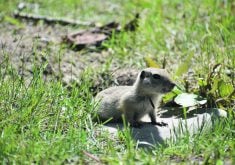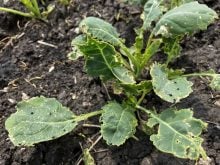INTERNATIONAL PEACE GARDEN, Manitoba-North Dakota border — Aging shelter belts and windbreaks are common across the Prairies and the U.S. Plains.
However, age is only one reason why some of them are no longer in good condition, and removing them isn’t the only solution.
Steve Rasmussen, forester with the Nebraska Forest Service, said sometimes the original design of the windbreak wasn’t right.
Often, proper maintenance would have kept the trees healthy and doing their jobs.
Foresters have identified eight attributes to determine what a shelter belt requires. The shelter belt could be considered in good condition if at least seven are positive, while five or six indicators would be fair and four or fewer would be poor.
Read Also

Growing garlic by the thousands in Manitoba
Grower holds a planting party day every fall as a crowd gathers to help put 28,000 plants, and sometimes more, into theground
- There should be no more than 25 percent dead trees.
“That’s somewhat arbitrary,” Rasmussen said. “For a single row windbreak, it’s probably going to be a bad thing.”
- Do the trees still form a continuous barrier or are there gaps?
Rasmussen said this assessment depends on its function.
“If it’s a field windbreak, we don’t want to have those gaps in there because your wind blowing through is going to defeat the purpose,” he said.
This assessment is critical for shelter belts around farmsteads.
- Density of the windbreak should be examined from a distance and in the season for which the windbreak was designed. For example, if it is supposed to be catching snow, examine it in winter.
Field windbreaks could be a different density than a wildlife buffer or a riparian buffer.
- He advises removing sod-forming grasses around the belt.
“Smooth brome is really a tough competitor, especially when young trees are growing,” he said. “It’s also a monoculture.”
- The health of tree crowns should be assessed. No more than 25 percent should show insect or disease problems.
- The presence of livestock and their effect on trees is another consideration. Little to no livestock activity around the windbreak is preferable from the trees’ point of view.
“Livestock can do a lot of damage,” he said.
Cattle rubbing and chewing on trees and compacting soil around them affect the health of the stand.
- Tree regeneration is important, particularly if renovation is likely to occur. New volunteer trees will mean fewer have to be planted.
“You’re going to be able to sustain that windbreak with those new trees.”
- Could the trees live another 20 years?
Other indicators could be aesthetics, lack of diversity and original row spacing that is too close.


















